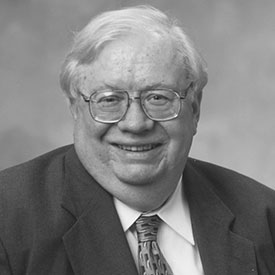The Jesse Tree: 4th Week of Advent
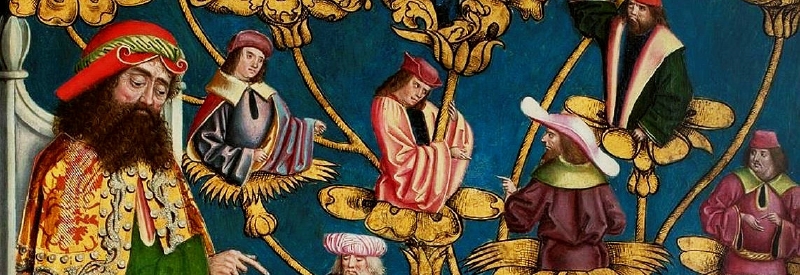
The ornaments of the Jesse tree tell the story of God in the Old Testament, connecting the Advent season with the faithfulness of God across four thousand years of history.
We’ve included people and ornaments for each day during a long Advent season of 28 days. When the season is shorter, you may wish to use some of these stories during the third week of Advent.
Sunday: John the Baptist
Ornament: Scallop Shell

John the Baptist
Jesus had immense respect for John the Baptist saying: “Among those born of women no one has arisen greater than John the Baptist” (Matthew 11:11). John was called by God to be a prophet and prepared himself to follow this call. Dedication to a goal means some reevaluation of priorities. John apparently wanted to be free of any obligations except getting ready to proclaim the coming of the Messiah. He wanted people to know that the time for the Messiah to come was near. This meant that their priorities in life needed to be reconsidered. When we realize that we are being called to a new life in Christ, we have to consider what sacrifices we are going to be called to make to change our lives. While we will not be called to the extremes that John the Baptist was, we also need to recognize that life has to be different if we are going to be faithful.
John the Baptist Preaches Repentance — Luke 3:1–6
Messengers from John the Baptist — Matthew 11:2–11
Monday: Mary
Ornament: White Lily
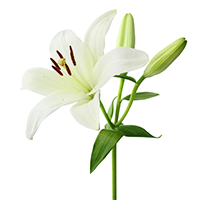
The Annunciation
When we think of heroes in Scripture, Mary, the mother of Jesus, does not usually come to mind. But consider the risks she was taking when she said yes to becoming the mother of the Messiah (Luke 1:38). She was a young girl of about sixteen years old living in a small village where every secret is known and every fault is criticized. She lived in an occupied land and could be subject to any command from the occupying army. She faced an unknown future. The experience of speaking to God’s messenger must have been terrifying in itself. It is perhaps fitting that we consider Mary our greatest hero, leader, champion, and saint. Her decision made it possible for us to discover what it means to live in Jesus.
The Annunciation — Luke 1:26–38
Tuesday: Elizabeth
Ornament: Mother and Child
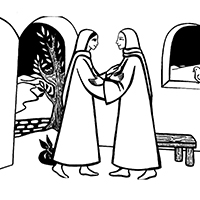
Mary Visits Elizabeth
After the angel left Mary, she immediately went to see her cousin Elizabeth. Mary had learned from Gabriel that Elizabeth would soon have a son who would grow up to be John the Baptist. As Mary comes into her presence, Elizabeth experiences the Holy Spirit filling her life. She calls out to Mary the words of blessing we repeat with every Hail Mary; “Blessed are you among women, and blessed is the fruit of your womb” (Luke 1:42). Elizabeth then asks, “And why has this happened to me, that the mother of my Lord comes to me?” (Luke 1:43). These recall the words of King David when the Ark of the Covenant was brought back to Jerusalem, “How can the ark of the Lord come into my care?” (2 Samuel 6:9) Just as the Ark of the Covenant symbolized the presence of the Lord, the God of Israel, Mary’s visit sanctifies Elizabeth’s home with the presence of the Lord.
The Visitation — Luke 1:39–45
Wednesday: Zechariah
Ornament: Pencil and Tablet
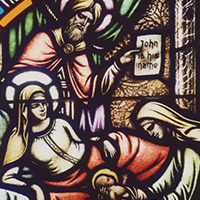
His Name Is John
When the angel revealed to aged Zechariah that he would have a son, Zechariah asked for proof. As a result, he was silenced. Zechariah’s wife Elizabeth conceived their first child. Elizabeth was grateful to God, “This is what the Lord has done for me when he looked favorably on me and took away the disgrace I have endured among my people” (Luke 1:25). When their son was born, Elizabeth said that he would be called John (“the Lord is gracious”). Elizabeth’s relatives objected, as no other family members had the name. Zechariah asked for a tablet and wrote “His name is John.” (Luke 1:63) Then Zechariah immediately spoke, blessing and praising God. The relatives were filled with awesome reverence over God’s wonderful deeds. Zechariah then proclaimed the prayer which we know from its Latin name the Benedictus. Every morning the Church blesses the Lord, the God of Israel, who has visited and set the people free. In this prayer—found in Luke 1:68–79—are the perfect words to prepare us to welcome the celebration of the coming of Jesus.
The Birth of John — Luke 1:57–66
The Canticle of Zechariah — Luke 1:68–79
Thursday: Joseph
Ornament: Carpenter’s Square or Hammer
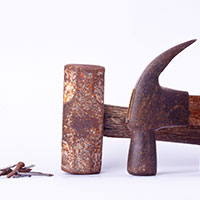
Joseph, Do Not Be Afraid
What a wonderful father Joseph was for Jesus. We first meet Joseph in Matthew 1:18-25 as he contemplates how to deal with Mary’s pregnancy. Joseph is an honest, caring man who does not want to embarrass Mary, so he intends to quietly divorce her. Imagine his wonderment and joy as he heard from the angel the good news and true identity of Jesus. Joseph continued his caring in times of danger as they escaped to Egypt. Luke speaks of his concern for Jesus when they finally found him in the Temple (Luke 2:41-52). Along the way it is Joseph who had primary responsibility for Jesus’ religious education. He would also be the one to teach Jesus the fundamentals of carpentry. In his faithful listening and open heart, Joseph is a model for all to understand and love Jesus whose birth we prepare to celebrate.
An Angel Appears to Joseph — Matthew 1:18–25
The Finding of Jesus in the Temple — Luke 2:41–52
Friday: Jesus
Ornament: Manger

Born in Humble Circumstances
Luke connects Jesus’ birth to the world-wide stage. The Roman Emperor Caesar Augustus (63 B.C.–14 A.D.) was praised as savior and bringer of peace, which he accomplished by defeating his enemies. Luke contrasts Augustus’s accomplishments with Jesus the Savior. While the world looks to the political center for peace, Luke tells us to look at the outskirts of the empire. Jesus is born in humble circumstances. He is wrapped in swaddling clothes as a sign of his humanity. Jesus is laid in a manger, a feeding trough for animals, as a sign that Jesus is to be food for the world. The Gospel of Luke is especially concerned for the poor, the outcast, those on the margins of society. This concern is never more apparent than in the proclamation of the Savior to the shepherds (Luke 2:8-14). Shepherds lived on the margins and were not well respected by society, yet they are the first to hear of the Messiah. They were also the first to step out in faith to celebrate his birth. When we celebrate Jesus’ birth this Christmas season, we will be following in the footsteps of the shepherds. Like Mary, we will have much to reflect upon in our hearts.
The Birth of Jesus — Luke 2:1–20
Saturday: Christ
Ornament: Chi-Rho
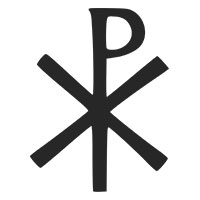
In the Beginning Was the Word
When we celebrate Mass on Christmas, the Gospel readings change depending on the time of the Mass. For the Christmas Vigil Mass on the evening of December 24, the reading is from the Gospel of Matthew (Matthew 1:1-25), beginning with the genealogy tracing Jesus’ ancestry in the Old Testament and ending with the revelation to Joseph. For Midnight Mass and the Mass at Dawn, the traditional readings are from the Gospel of Luke (Luke 2:1-20). At the Mass for Christmas day, the reading is from John 1:1-34. In the first readings the narrative carries us along into the mystery of Jesus’ birth. The text from John calls us to meditate on the meaning of the stories we have heard. “In the beginning was the Word, and the Word was with God, and the Word was God” (John 1:1). When we are reflecting on Jesus Christ, we are reflecting on God, and through him has come all life (John 1:3-4). In Jesus, God has become one of us, made his dwelling among us, pitched his tent in our midst. When we enter into relationship with Jesus Christ, we enter into the heart of God. When we share the love Jesus has won for us, we share the heart of God with one another. The wonder of Christmas reflects this for us and is the gift we bring for one another.
The Genealogy and Birth of Jesus — Matthew 1:1–25
The Birth of Jesus and the Visit of the Shepherds — Luke 2:1–20
In the Beginning Was the Word — John 1:1–18
Most of the information in this presentation is excerpted from The Stories of the Old Testament: A Catholic’s Guide by Jim Campbell.


